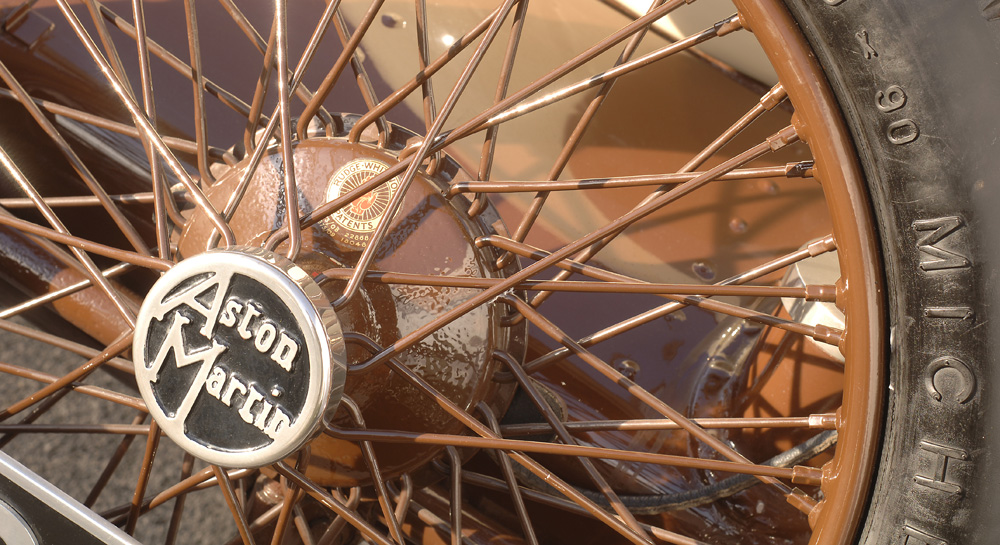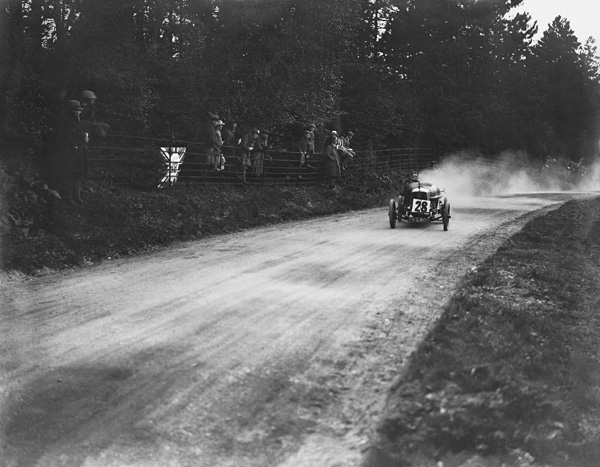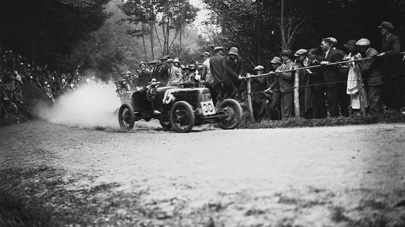Previous Article
Next Article
- AM WORLD
- FEATURES
- 100 YEARS OF ASTON MARTIN
- ARCHIVE
CENTENARY

THE EARLY YEARS
In the first of a three-part history of Aston Martin, Richard Meaden looks back over an eventful first few decades for the company

A full view of the Bamford and Martin side-valve team car; Count Louis Zborowski participating in the Light Car Derby at Brooklands in 1921
THE ORIGINS OF ASTON MARTIN lie with two men. Robert Bamford was a 30-year-old engineer with an enthusiasm for anything with four wheels and a good turn of speed. Lionel Martin was an immaculately dressed, 35-year-old old Etonian with a burning passion for racing.
Bamford worked for Hesse and Savory, producing boat engines, and was put in charge of their London depot in Henniker Mews, off the Fulham Road in West London, when they expanded into motor cars. In his spare time, he was a proficient racing cyclist, which is where he met Lionel Martin. When Hesse and Savory decided not to continue with the motoring side, Bamford and Martin took over Henniker Mews. They founded Bamford and Martin Ltd on 15 January 1913 with backing from Martin, whose family had made its fortune in the mining industry.
The company started by selling Singer sports cars to most of southern England and business was good. However, the founding partners wanted to create their own car, taking some of the qualities of the Singer but improving durability and performance. The cars were to be called Aston Martin, as Lionel Martin recalled: “After reviewing all the flowers, beasts, birds and fishes that we knew, we got to place names. And as my Singer had recently scored a point or two at the Aston Clinton Hillclimb, the first part of that name was adopted with acclamation and my simple cognomen appended to it.” The first Aston Martin was registered on 16 March 1915.
The conflict raging throughout Europe halted progress but Aston Martin regrouped in 1920 and produced a prototype from its new base on Abingdon Road, Kensington. Bamford, who cared little for the idea of greater production numbers, left the company, to be replaced by Kate Martin, Lionel’s wife.
In 1920, Count Louis Zborowski became involved in the company. The Count’s father had speculated and won handsomely on the Wall Street markets but, when settling in London, decided that his American roots weren’t a good fit, so he created a persona as a member of the Polish aristocracy. Louis, happy to continue the pretence, was a real extrovert and his parties at the family’s country home in Higham, near Canterbury, were legendary. They often culminated in the explosion of small houses that he’d had built on the land just to destroy in spectacular fashion. Count Zborowski invested heavily in Aston Martin but his life was cut short when he died, aged 29, in a Mercedes-Benz at the 1924 Italian Grand Prix at Monza.

FB Halford wins the 1500cc class in his “Bunny” at the 1923 Herts County Automobile Club Open Hillclimb
The Count had achieved various speed records for the company in 1921. The following year, drivers H Kensington-Moir, Clive Gallop and Sammy Davis drove a prototype (nicknamed “Bunny”) to a Brooklands record. Yet despite Aston Martin’s rising stature and recognition across the world, it failed to become economically viable.
The company went into receivership in 1925 and Lionel Martin left to focus on designing bicycles. However the company was rescued under Lord Charnwood, John Benson, Cesare Bertelli and William Renwick. Relocated to Victoria Road, Feltham, in Middlesex, it was renamed Aston Martin Motors.
Bertelli (“Our Bert”) became Aston Martin’s driving force and a series of cars followed that were fitted with a dry-sump 1.5-litre overhead camshaft four-cylinder engine designed by Bertelli and Renwick. The International, Le Mans and Ulster models were fitted with bodies styled by Augustus’ brother, Enrico (Harry) Bertelli, and went on to considerable motorsport success. In 1932, Cesare Bertelli and Pat Driscoll won the Biennial Cup at the Le Mans 24-hour race. Yet racing glory, still at the very core of Aston Martin, didn’t bring commercial stability and, in the same year, the company was sold to Sir Arthur Sutherland, with his son Gordon taking over as Managing Director.
Under this new ownership, the focus shifted to high performance luxury road cars and the new 2-litre 15/98 model emerged to much acclaim. In 1935, 65 Aston Martins were produced. On 25 May that year, an enthusiastic group of owners met at The Grafton Hotel in London to found the Aston Martin Owners’ Club, which has grown to become the biggest single marque club in the world.
Cesare Bertelli left the company in 1936, but his innovative spirit remained. As storm clouds gathered over Europe once again, an advanced new prototype was being developed by Aston Martin. Designed by Claude Hill, it featured an early type of tubular space-frame construction, independent front suspension and an aerodynamic shape formed from light aluminium bodywork. It was called the Atom and was to inspire a whole new generation of Aston Martins after the Second World War.

The Atom, an avant-garde prototype developed using an early form of space-frame chassis and independent suspension, was first produced in 1939
CENTENARY
Previous Article
Next Article
- AM WORLD
- FEATURES
- 100 YEARS OF ASTON MARTIN
- ARCHIVE




